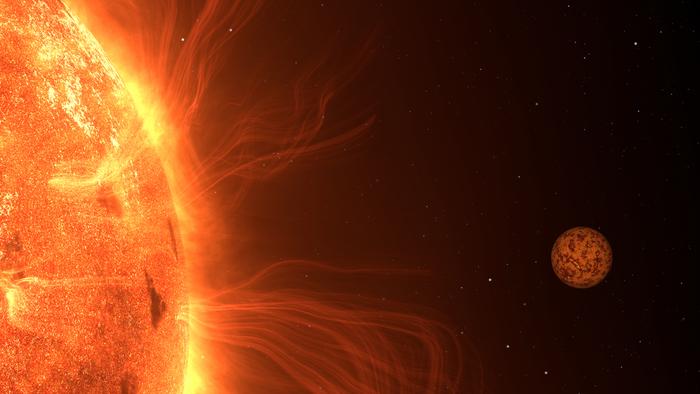
December 18, 2024 by Mark Thompson
Collected at: https://www.universetoday.com/170140/one-of-the-most-interesting-exoplanets-just-got-even-more-interesting/
Since the discovery of the first exoplanet in 1992, thousands more have been discovered. 40 light years away, one such system of exoplanets was discovered orbiting a star known as Trappist-1. Studies using the James Webb Space Telescope have revealed that one of the planets, Trappist-1 b has a crust that seems to be changing. Geological activity and weathering are a likely cause and if the latter, it suggests the exoplanet has an atmosphere too.
Exoplanets are planets that orbit around other stars. In every way they vary in size, composition and distance from their star. Finding them is quite a tricky undertaking and there are a number of different approaches that are used. Since the first discovery, over 5,000 exoplanets have been found and now of course, the hunt is on to find planets that could sustain life. Likely candidates would be orbiting their host star in a region known as the habitable zone where the temperature is just right for a life sustaining world to evolve.

There are three exoplanets in the Trappist-1 system that orbit the star within the habitable zone; Trappist-1e, f and g. The star is a cool dwarf star in the constellation of Aquarius and was identified as being a host of exoplanets in 2017. The discoveries were made using data from NASA’s Kepler Space Telescope and the Spitzer Space Telescope. The system was named after the Transiting Planets and PlanetesImals Small Telescope (TRAPPIST.)

A team of researchers from the Max Planck Institute for Astronomy and the Commissariat aux Énergies Atomiques (CEA) in Paris have been studying Trappist-1b. They have been using the Mid-Infrared Imager of the James Webb Space Telescope to measure thermal radiation from the exoplanet. Their findings have been published in the journal Nature Astronomy. Previous studies concluded that Trappist-1b was a dark rocky planet that and no atmosphere. The new study has turned this conclusion on its head.
The measurements found by the team revealed something else. They found a world with a surface composed of largely unchanged material. Typically the surface of a world with no atmosphere is weathered by radiation and peppered with impacts from meteorites. The study found that the surface materials is around 1,000 years old, much younger than the planet itself which is thought to be several billion years old.
The team postulate that this could indicate volcanic activity or plate tectonics since the planet has sufficient size to still retain internal heat from its formation. It’s also possible that the observations reveal a thick atmosphere rich in carbon dioxide. The observations suggested at first that there was no layer of carbon dioxide since they found no evidence of thermal radiation absorption. They ran models however to show that atmospheric haze can reverse the temperature profile of a carbon dioxide rich atmosphere. Typically the ground is the warmest region but in the case of Trappist-1b, it may be that the atmosphere absorbs radiation, this heats the upper layers which radiates the infrared energy itself. A similar process is seen on Saturn’s moon Titan.
Fortunately, the alignment of the planetary system means that it passes directly in front of the star so that spectroscopic observations and the dimming of starlight as the planet passes in front can reveal the profile of the atmosphere. Further studies are now underway to explore this and take further observations to conclude the nature of the atmosphere around Trappist-1b.
Source : Does the exoplanet Trappist-1 b have an atmosphere after all?

Leave a Reply